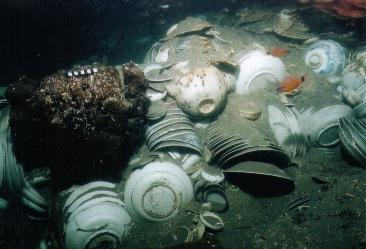Located 60 miles south of where the Tigris and Euphrates Rivers empty into the Persian Gulf, Failaka Island has been a strategic location since the rise of Ur, the great ancient Mesopotamian city during the third millennium BC. From that location the maritime trade that passed by the Persian Gulf could be protected. Two harbors were built on the Island, and potable water and fertile soil allowed its occupation among the centuries.
The ancient Indian city of Dwarka is known in Hindu culture to have been the great and beautiful city of Krishna. The Hindu writings say that when Krishna left the Earth to join the spiritual world, the age of Kali began and Dwarka and its inhabitants were submerged by the sea. The tales of the submersion can also evoke a tsunami like the one that struck India in 2004.

The Ca Mau shipwreck was a Chinese junk, almost certainly en route from Canton (now Guangzhou) to the Dutch trading port of Batavia (now Jakarta).
The shipwreck was in the sea depth of 36m with some obscure tracks of 24m long and about 8m wide.
Bredenhof (1753)
Silver bar from the Bredenhof shipwreck (http://www.icollector.com/Silver-bar-1740-grams-about-98-5-fine-with-stamps-of-the-Middelburg-chamber-of-the-VOC-Dutch-Ea_i10430672)
VOC Bredenhof was a Dutch East Indiaman transport ship that foundered on a reef 120 miles south of Mozambique and only 13 miles off the South African coast, near the Cape of Good Hope, on the 6th June 1753. It was commercially exploited by treasure-hunters.
More than 12 000 items of Chinese Ceramics were recovered from a shipwreck located about 50 km from Belanakan, West Java in Indonesia. The shipwreck lies at a depth of 58 meters in the Java Sea and measures 50 meters by 20 meters. Archaeologists believe that the blue and white wares originate from the Ming dynasty.
Batam wreck
© World Imaging
The wreck of this small ship is located near the Indonesian Island of Batam, about 100 meters from the coast. It could be of Indonesian origin and used for inter-Island trading in the early 17th century. This wreck is an important source referring to Swatow wares that were produced during the Wanli period (1572-1620 AD).
12th-13th century Wreck
© Area Marina Protetta Porto Cesareo
The wreck of an ancient ship has been found off the coast of Salento, in the southern tip of the Puglia region in Italy, in 2015. The ship is made almost entirely of wood and measures 18 meters by 4,5 meters. A local fisherman made the discovery and notified the authorities who have sent divers to investigate. The wreck lies in the Porto Cesareo Marine Protected Area near to a medieval fishing village.
Wooden Tablet
© The National Museum of Korea
Some 360 wooden tags were found and provided decisive information about the shipwreck. Thy have the cargo owner’s name, temple names, production dates, and kinds and quantities of goods. They were written with brush and ink.
Provenance: Dodeok-do, Bangchuk-ri, Jido-myeon, Sinan-gun, Jeollanam-do
Materials: wood
Accession Number: Sinan 23584
Vessel decorated with a rowing boat
Methods of communication are essential to the dialogue of cultures. And for the inhabitants of the Nile Valley, the sailing vessel, as can be seen by this vase; was one of the most effective and oldest methods. The vase is a typical example from the culture known as Naqada II (the period around 3500-3200 BC) which was one of the last phases of Egyptian Prehistory and whose epicentre was the Naqada site in Upper Egypt.






